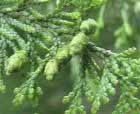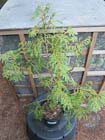Conservation Status

Thuja sutchuenensis
Franchet 1899
Common names
崖柏, ya bai [Chinese]; Sichuan Arborvitæ.
Taxonomic notes
Syn.: Thuja sutchuensis (orth. err.). Type: Sichuan, Chengkou County, P.G. Farges 1158 (P).
Description
Trees to 20 m tall, sometimes shrubs; usually with a single round trunk to 30 cm dbh and a pyramidal crown of spreading, ascending branches. Bark fibrous, orange-brown when young, turning gray-brown, thin, soon flaking. Twigs not glaucous, flattened, in pinnate frond-like sprays. Leaves imbricate, decurrent, appressed, dimorphic (on whip shoots nearly homomorphic and up to 9 × 3mm), all scale-like, on (sub)ultimate branchlets 1.5–4 × 1–1.5mm. Facial leaves rhombic to diamond-shaped, weakly keeled, apex obtuse; lateral leaves slightly larger, broadly falcate, partially covering the base of facial leaves but spreading from their apex, bilaterally flattened, incurved, obtuse; stomata borne primarily on the underside of lateral and on the adjacent facial leaves; leaves lustrous green, each with a single resin cavity.
Pollen cones yellow-green maturing brown; terminal, solitary, subglobose, 2-3 mm long; microsporophylls 6-8, each with (2 or)3 pollen sacs. Seed cones terminal; ellipsoid, 5-8 × 3-4 mm; fertile cone scales 4, slightly spreading. Seeds ovoid-oblong, 3-4 × 1.5 mm; wings 2, marginal, 0.5 mm wide, of equal size and shape, surrounding
the seed but leaving a notch at both ends. Cotyledons 2 (Fu et al. 1999, Xiang et al. 2002). The only other Thuja with obtuse leaves is T. koreana; its facial leaves bear a gland and its young branchlets are glaucous (Xiang et al. 2002).
Distribution and Ecology
Before 1999 it had not been collected in the wild since it was discovered at 1400 m elevation in NE Sichuan (the SE Daba Shan area in Chengkou Xian) by missionary P.G. Farges, who collected it in 1892 and 1900. It was accordingly thought to be extinct in the wild (Fu et al. 1999). However, in 1999 it was rediscovered by Chinese botanists in the same region, in a 20 ha area within the Daba Mountain Nature Reserve near Chongqing. This had previously been the only example, among the conifers, of a species thought to have become extinct during historical time (Xiang et al. 2002). The Chinese government has committed itself to protecting these trees and their habitat, which also contains many other endangered plant species (People's Daily, 2001.04.15)
Grows on limestone, mostly on ridges or steep S-facing slopes, at (800-)1000-1500(-2100) m elevation. Climate is humid warm temperate, with a January mean of 2.4°C, a July mean of 24.8°C, and a mean annual precipitation of 1418 mm. Soils are usually thin, but rich in organic matter and accordingly, slightly acidic (pH 6.2-7). On more productive sites it is usually replaced by evergreen broadleaf trees. Common associates include Cotoneaster salicifolius var. rugosus, Coriaria nepalensis, Itea ilicifolia, Cotinus cogyria var. pubescens, and several shrubs growing on rocks, e.g. Pyracantha, Spiraea, Sorbus, Rosa, Rubus, Desmodium, Lespedeza, Pittosporum, Eurya, Ilex, Zanthoxylum, Euonymus, Buddleija, Ligustrum, Symplocos, Viburnum and Lonicera. The primary epiphytic mosses are usually Palamocladium nilgheriense, Aomaliodendron scalpellifolium and Cololegieunea
ocellata (Xiang et al. 2002).
Hardy to Zone 6 (cold hardiness limit between -23.2°C and -17.8°C) (Bannister and Neuner 2001).
Remarkable Specimens
The surviving population is estimated to include trees 500 to 600 years old (People's Daily, 2001.04.15).
Ethnobotany
At the time the species was rediscovered, local people used the soft, easily-worked wood for home construction, shingles, and other uses requiring decay resistance (Xiang et al. 2002).
Observations
Remarks
The spelling of the specific epithet derives from Sutchuen (French for Sichuan), plus the ending -ensis (originating from).
Citations
Frankis, M.P. 2003.03. Series of e-mails posted to Conifers Forum.
Franchet. 1899. Plantarum sinensium ecloge tertia. Journal de Botanique 13:262-263.
Jacobson, A.L. 2012. Plant of the Month: September 2012. Sichuan Arborvitæ or Thuja
Thuja sutchuenensis Franch. CUPRESSACEÆ; Cypress Family. www.arthurleej.com/p-o-m-Sept12.html, accessed 2012.10.20.
People's Daily. 2001.04.15. http://fpeng.peopledaily.com.cn/200104/15/eng20010415_67749.html, accessed 2003.04.09, now defunct.
Xiang Qiaoping, Farjon, Aljos, Li Zhenyu, Fu Likuo and Liu Zhengyu. 2002. Thuja sutchuenensis: a rediscovered species of the Cupressaceae. Botanical Journal of the Linnaean Society 139(3):305-310. LINK (accessed 2012.10.20). ABSTRACT: After more than a century, the only conifer species listed as being extinct in the wild (EW) by IUCN-SSC has been rediscovered in the Dabashan Mountains of central China. The history, taxonomy, ecology and conservation of Thuja sutchuenensis are described, and illustrations, based on both the earliest and latest collection of botanical material of this tree, are provided. The taxonomic context of this rare species is discussed.
See also
The species account at Threatened Conifers of the World.
Farjon 2005.





